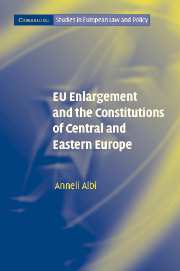Book contents
- Frontmatter
- Contents
- List of tables
- Series Editors' Preface
- Acknowledgements
- Table of cases
- Table of treaties, laws and other instruments
- List of abbreviations
- Introduction
- 1 Overview of the accession process
- 2 Constitutional adaptations in the ‘old’ Member States
- 3 Some idiosyncrasies of CEE constitutions
- 4 Constitutional issues in the pre-accession period
- 5 Revision of CEE constitutions for EU membership
- 6 Theoretical views of sovereignty and democratic legitimacy in CEE
- 7 Referendums
- 8 Membership of NATO and other international organisations
- 9 Role of Constitutional Courts
- 10 Implications of the European Constitution
- Epilogue: ‘Taking constitutions seriously’ in the process of European integration
- Bibliography
- Appendix
- Index
10 - Implications of the European Constitution
Published online by Cambridge University Press: 28 July 2009
- Frontmatter
- Contents
- List of tables
- Series Editors' Preface
- Acknowledgements
- Table of cases
- Table of treaties, laws and other instruments
- List of abbreviations
- Introduction
- 1 Overview of the accession process
- 2 Constitutional adaptations in the ‘old’ Member States
- 3 Some idiosyncrasies of CEE constitutions
- 4 Constitutional issues in the pre-accession period
- 5 Revision of CEE constitutions for EU membership
- 6 Theoretical views of sovereignty and democratic legitimacy in CEE
- 7 Referendums
- 8 Membership of NATO and other international organisations
- 9 Role of Constitutional Courts
- 10 Implications of the European Constitution
- Epilogue: ‘Taking constitutions seriously’ in the process of European integration
- Bibliography
- Appendix
- Index
Summary
EU's constitutional reform and involvement of candidate countries
One of the novelties of this enlargement is that for the first time, a major constitutional and institutional reform has been necessary on the part of the EU. In fact, the requirement that the EU must adapt its institutions for enlargement constituted the fourth part of the Copenhagen Criteria, being addressed to the EU itself rather than to the candidate countries. The EU institutions were notably designed for six countries, and having been increasingly under strain with fifteen, a dramatic increase in the number of Member States was expected to be particularly challenging. Another reason for institutional reform was the advent of many small-sized countries or even micro-states: Malta and Cyprus have a population of respectively 400,000 and 800,000; Estonia 1.4 million; Slovenia 2 million; Latvia 2.4 million; Lithuania 3.7 million; Slovakia 5.4 million. Only Poland is a bigger player with 40 million people; Hungary and the Czech Republic each have a population of about 10 million. Although numerical adjustments for enlargement were made in the Treaty of Nice, these were widely considered to be a bare minimum, failing to respond to deeper challenges. Besides addressing the challenges of enlargement, the constitutional reform was also aimed at simplifying the current maze of treaties and making them more understandable to citizens, as well as increasing democracy and efficiency in the Union.
- Type
- Chapter
- Information
- Publisher: Cambridge University PressPrint publication year: 2005



